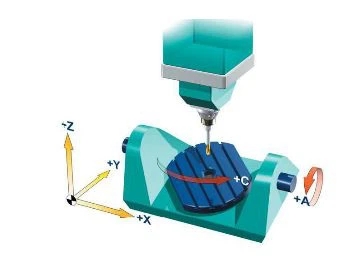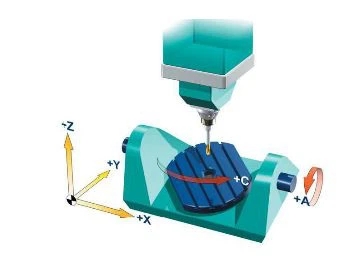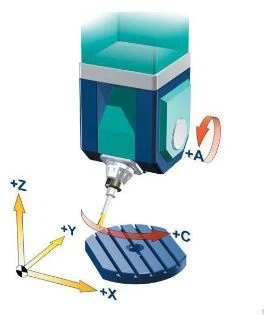Different Types Of Vertical 5 Axis Machining Centers
Vertical 5 axis machining centers are developed from the basic conventional vertical machining center (3 axis). On the basis of the original structure of the conventional vertical machining center (3-axis), two rotating axes are added, that is, the vertical 5 axis machining center, which has three linear coordinate axes and two rotating coordinate axes. According to the different positions of the two rotating axes, the vertical 5 axis machining center can be divided into three types: two rotating axes are set on the worktable, two rotating axes are set on the spindle, one rotating axis is set on the spindle, and the other rotating axis is set on the worktable. The following describes the type and characteristics of vertical 5 axis machining centers.

The first type of vertical 5 axis machining center installs two rotating axes on the worktable, and one rotating axis rotates around the X axis. We define it as A axis. the working range of axis A is usually + 30 degrees to - 120 degrees. The other rotation axis rotates around the Z axis, which is defined as the C axis. The working range of the C axis is usually 360 degrees. Through the combination of A-axis and C-axis, the vertical 5 axis machining center can process all surfaces except the mounting surface. The minimum division value of A-axis and C-axis is 0.001 degrees. There is no dead angle on the machining surface of the workpiece, except the mounting surface, which can process surfaces such as inclined holes, etc.

The second type of vertical 5 axis machining center is to install two rotating shafts on the spindle, and a rotary head is installed at the front end of the spindle to rotate around the Z axis. We define it as the C axis, and the working range of the c axis rotates 360 degrees. A rotating axis rotating around the X axis is also installed on the rotary head. We define it as the A axis. The working range of the A axis is generally more than ± 90 degrees, which can also realize the above functions. The advantage of this kind of rotating axis setting method is that the spindle processing is very flexible, and the worktable can be set to infinity, which can process very large workpieces, such as aircraft fuselage, huge turbine engine shell and other large complex curved surface workpieces.

The last type of vertical 5 axis machining center installs two rotating shafts on the spindle and worktable respectively. There is a rotating head at the front end of the spindle to rotate around the X axis. We define it as A axis, and the working range of axis A is more than ± 90 degrees. A rotating shaft is installed on the worktable to rotate around the Z axis, which is defined as the C axis. The working range of the C axis is 360 degrees. The advantage of this rotating axis setting mode is that the worktable and spindle are equipped with linkage processing, which is very flexible, and can process box workpieces with complex curved surfaces.